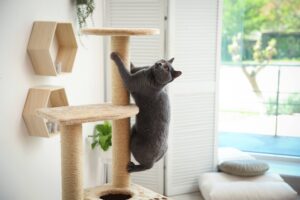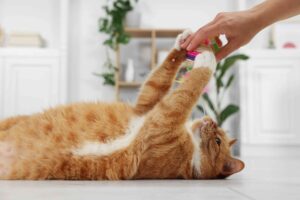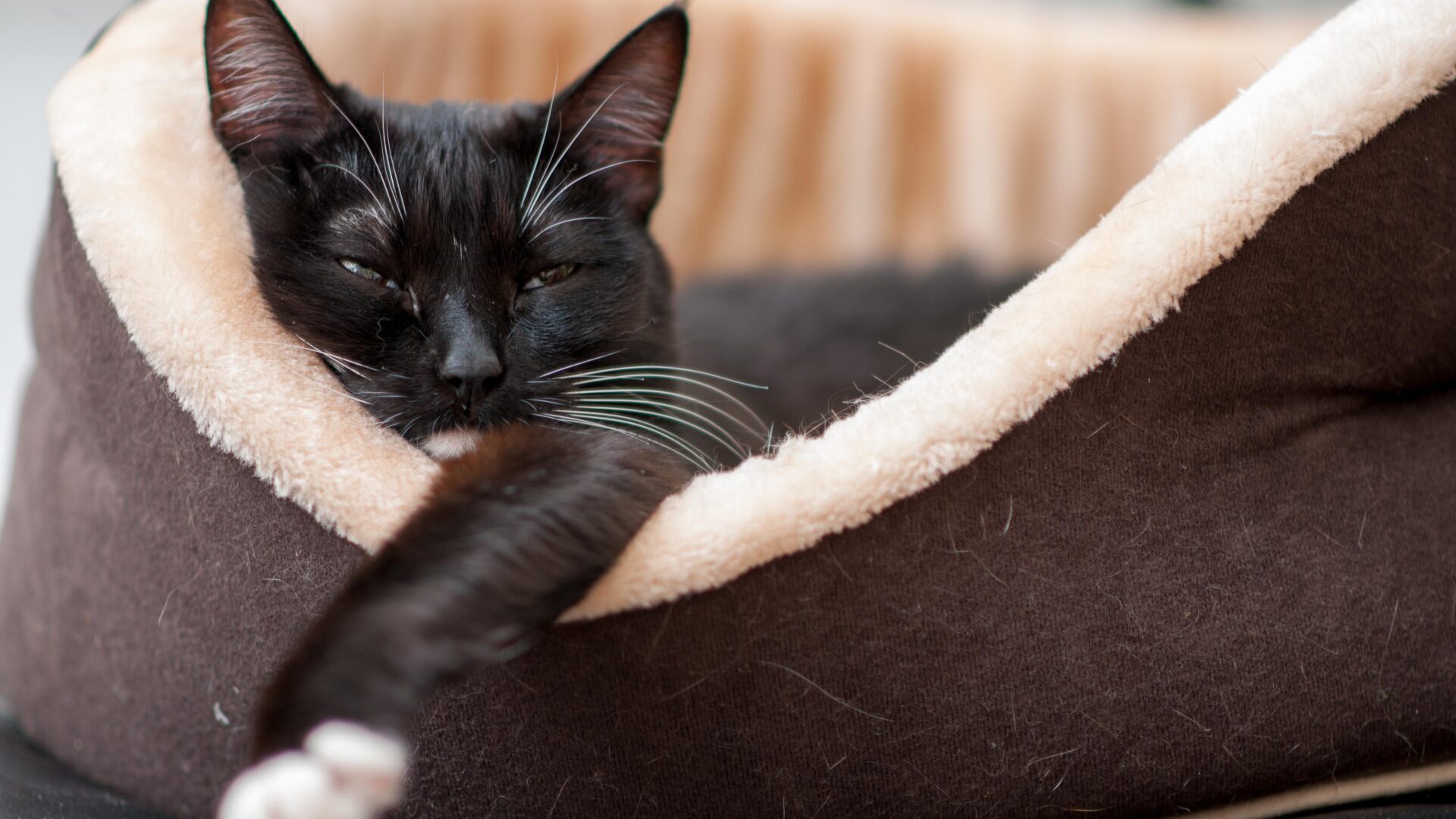The fast pace of modern living has certainly highlighted the rise in stress among us. We won’t have to scroll for long to find some reference to stress and the effects it has on our bodies.
So, what about our faithful feline companions? How are they coping with our ever changing hectic lives?
Health benefits of optimising and enriching environments for cats
Like humans, cats can become unwell if their environments don’t meet their needs, and they become stressed, anxious and frustrated.
The rise in stress hormones can have lasting effects on the gut and bladder lining, so they may need to visit the vets for support with inflammatory bowel conditions and cystitis.
Cats can become depressed and start to become withdrawn from their environment. Stress can also lead to a generalised change in behaviour, which may then be displayed through aggression or negative interactions between the humans within the family, as well as their feline companions. Often, the cat just stops responding, and stress in these individuals is difficult to spot.
Cat owners should optimise their cats’ environments to meet their needs and support their emotional wellness.
Why is this even more crucial for indoor cats?
We only have to look back at the ancestors of our feline friends to realise what they may need. As free-roaming solitary survivors, they are kitted out with all the tools to survive.
They are born with the ability to hunt, patrol territory, maintain resources, keep safe and communicate with each other as a species.
So, what if we are unable to let our cats out due to busy roads, apartment living or health issues?
We have to ensure that the indoor environment offers the cat the opportunity to express as many of its natural behaviours as possible.
Obviously, you will have thought about the need for food, water and warmth, but have you considered your cat’s need to hunt, their need to be able to retreat and hide undisturbed and their need to feel in control?
Considering the behavioural needs of your cat is not difficult, but it does require some time, some thought and some commitment

The five types of optimising/enriching: physical, sensory, occupational, social and nutritional
In order to tick all the boxes and feel that we are offering the best for our cats, we need to look at all their needs and how we can adapt and add to enrich their environment.
- Provide space for them to exercise, climb, hide, chase and sleep.
- They need to be able to access different textures, natural scents and stalk toys.
- Allow them to explore and get up to high vantage points, as well as mimic the predatory prey sequence through games.
- Provide them with a high-quality, high-protein diet and introduce a problem-solving element using puzzle feeders.
- Consider their key vital resources and how they are provided: food, water, sleep, scratching, hiding, resting, playing and toileting.
Multi-cat households can cause stress and anxiety, which can manifest in a cat’s health and behaviour.
You may find that they spray as they urinate, over-groom or pick up common stress-related illnesses such as cystitis. They may even leave the house and look to settle elsewhere.
All cats live within a territory, and within this, they need to feel safe and secure. They need to be able to eat/drink/toilet and rest without the fear of an enemy attack.
Therefore, it is very important that their home meets these needs, especially if you will be having two or more cats living together.
We need to remember that free-roaming cats would choose who they live with, so when we put cats together, it may not necessarily work out and we may not easily spot this.
Sadly, if their needs are not met it can lead to stress and behaviour-related problems like house soiling, urine marking and aggression (these are the most common reasons that cats are handed into rehoming shelters) or silent distress.
Cats need to be able to express their natural behaviours to ensure they balance their emotional and mental wellbeing. Most cats should be allowed to have outside time, but if this is not possible, then even more work needs to be done to enrich their indoor environment.
A cat’s basic needs
Space
- Cats need to have the opportunity to climb, explore, rest and hide without disturbance.
- Allow them up on the shelves (they can see so much more up high and will favour these), or leave some cupboards open so that they have a safe space to explore if they are feeling anxious about something.
Resources
- Cats need plenty of places to eat, drink, sleep and go to the toilet. In a multi-cat household, these should all be separate, and ideally private. The general rule is one per cat, plus one extra.
- In the wild, a cat would not choose to eat next to another cat, as competition over resources is stressful. They would continually move their sleeping places and sleep where they feel comfortable.
- As much as we would like to see them tucked into a cosy bed, unlike many dogs, our cats will not appreciate this luxury!
Opportunities to perform natural behaviour
- Cats may still want to hunt, even if they have a stomach full of food. It is the behaviour repertoire that comes with the hunting of the prey that is so important.
- If your cat isn’t able to have time outside, then it’s time to be vigilant within the house. Consider puzzles or activity feeders, which can be brought from shops or made at home using household items like toilet rolls and yoghurt pots.
- Cats need something/somewhere they can scratch. Scratching is used to stretch muscles/mark boundaries and sharpen claws. It’s all about finding the best material and best location to allow this, without them ruining your brand new sofa!
Playtime
- It is a common misconception that once cats reach adulthood, they don’t play. All cats with the right stimulation and toys will play.
- Early morning and evening are good times to play with cats, as their natural body clock is heightened at these times.
- Again, there are many types of toys available, or you can use things from your home or garden. Examples include toys with feathers, fur or squeak elements, or those that can be manipulated/scratched and bitten to allow a full repertoire of predatory behaviours – this will prevent frustration. The use of laser pens is not advisable, but if you are using laser pens, give something that your cat can “catch” and “kill” at the end of play.
- Don’t expect too much – three to five minutes is adequate, as cats can get bored easily!

For more information about enriching your cat’s life, you can find further resources below. If you have any questions please reach out to your veterinary practice.
- Cat-friendly home recommendations: https://icatcare.org/resources/cat-caregiver-guide-home-modifications.pdf
- Making your home cat-friendly – International Cat Care: https://icatcare.org/articles/making-your-home-cat-friendly
- The ideal environment for cats – PDSA: https://www.pdsa.org.uk/pet-help-and-advice/looking-after-your-pet/kittens-cats/ideal-environment-for-cats
Written by:
Zoe Blake RVN ISFMCertFN AdvCertFB MISAP – Veterinary Nurse, Anderson Abercromby Vets
